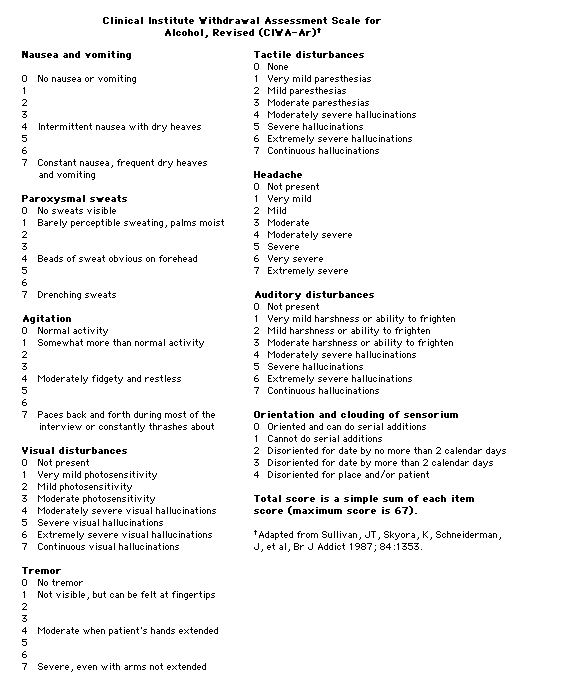Alcohol withdrawal
For patient information, click here
Editor-In-Chief: C. Michael Gibson, M.S., M.D. [1] ; Associate Editor(s)-in-Chief: Aditya Govindavarjhulla, M.B.B.S. [2]
Overview
Alcohol withdrawal refers to symptoms that may occur when a person who has been drinking too much alcohol every day suddenly stops drinking alcohol.
Pathophysiology
- Prolonged exposure to alcohol results in inhibition of the inhibitory GABA A-type and NMDA-type glutamate receptors located in the CNS. Without the alcohol, greater CNS excitability results.
- Elevated norepinephrine has been found in the CSF of withdrawing patients. It is postulated that alpha 2-receptors are decreased resulting in less inhibition of presynaptic norepinephrine release.
Epidemiology and Demographics
- Alcohol abuse or dependence afflicts up to 15 million persons in the United States. It accounts for 100,000 deaths and an economic burden of over 100 billion dollars per year. The lifetime prevalence of alcohol abuse is approximately 14% and of alcohol dependence is 8%. Approximately 500,000 patients/year develop withdrawal that is severe enough to prompt pharmacologic management.
- Between 13% and 71% of persons admitted for detoxification have evidence of withdrawal.
- Approximately 3% of chronic alcoholics develop withdrawal seizures. Five percent of patients with alcohol withdrawal develop delirium tremens (DTs), which is associated with approximately 5% mortality.
Natural history, Complications and Prognosis
How well a person does depends on the amount of organ damage and whether the person can stop drinking completely. Alcohol withdrawal may range from a mild and uncomfortable disorder to a serious, life-threatening condition. People who continue to drink a lot may develop health problems such as liver and heart disease. Most people who go through alcohol withdrawal make a full recovery. However, death is possible, especially if delirium tremens occurs.
Diagnosis
Criteria
- History of cessation or reduction in heavy and prolonged alcohol use.
- 2 or more of:
- Autonomic hypereactivity
- Hand tremor
- Insomnia
- Nausea and vomiting
- Visual or auditory hallucinations
- Psychomotor agitation
- Anxiety
- Grand mal seizures
Clinical Institute Withdrawal Assessment for Alcohol revised (CIWA-Ar)
The CIWA (Clinical Institute Withdrawal Assessment)[1] is a common measure used in North American hospitals to assess and treat alcohol withdrawal syndrome and for alcohol detoxification. This clinical tool assesses 10 common withdrawal signs.[2] A score of more than 15 points is associated with increased risk of alcohol withdrawal effects such as confusion or seizures.

Scoring
| Cumulative Score | Approach |
| 0-8 | No medication needed |
| 9-14 | Medication is optional |
| 15-20 | Definitely needs medication |
| >20 | Increased risk of Delirium tremens |
Symptoms
- Common symptoms include:
- Anxiety or nervousness
- Depression
- Not thinking clearly
- Fatigue
- Irritability
- Jumpiness or shakiness
- Mood swings
- Nightmares
- Other symptoms may include:
- Clammy skin
- Enlarged (dilated) pupils
- Headache
- Insomnia (sleeping difficulty)
- Loss of appetite
- Nausea and vomiting
- Pallor
- Rapid heart rate
- Sweating
- Tremor of the hands or other body parts
- A severe form of alcohol withdrawal called Delirium tremens can cause:
- Agitation
- Confusion
- Seeing or feeling things that aren't there (Hallucination)
- Fever
- Seizures
Physical examination
- Abnormal eye movements
- Abnormal heart rhythms
- Not enough fluids in the body (dehydration)
- Rapid breathing
- Rapid heart rate
- Shaky hands
- Blood and urine tests, including a toxicology screen
Treatment
- No clinical findings can reliably predict who will or will not develop withdrawal. Risk factors for DTs: Previous DTs or detoxifications, Age >30, high degree of alcohol dependence, duration of abuse, the presence of moderate symptoms (CIWA >14) left untreated and concurrent medical illness are all strongly predictive. These findings should prompt intervention. Time abstinent may be a helpful negative predictor. In one large study, patients who were asymptomatic 36 hours after their last drink did not develop symptoms.
- All patients with alcohol abuse should receive 1mg folate QD, magnesium/ phosphate/potassium/fluid volume repletion and thiamine 100 mg IV/IM x1 then 100 mg QD.
- Treatment of alcohol related seizures is on an as needed basis with benzodiazepines. They tend to be transient phenomenon. phenytoin is ineffective in the management of withdrawal seizures, but may be indicated if another seizure disorder or status epilepticus is present. Long term medical suppression or prophylaxis is not indicated for withdrawal seizures. Neuroleptics lower the seizure threshold and should not be used in these patients; however, haloperidol has been used safely in conjunction with benzodiazepines (BDZs).
- BDZs are the cornerstone of therapy for minor withdrawal, seizures and DTs. Fixed schedule therapy, front loading therapy and symptom-triggered therapy have all been evaluated with similar efficacy. Symptoms triggered therapy was associated with less total administration of drug and shorter length of stay but has only been evaluated in patients without acute comorbid illness or seizures and should be restricted to only this limited group of patients.
- In the medically stable patient with no liver dysfunction 10 mg PO/IV is administered every hour till CIWA <10 or sedated. If the patient is stable but has liver disease, give 2 mg lorazepam IV/PO Q 1H till CIWA <10 or sedated. Calculate the total dose used and give this Q6H for 24 hrs. Use that latter regimen for the unstable patient.
- If CIWA is stable x24 hours then decrease the dose by 20%/day. If there is a history of DTs or seizures or the patient is unstable decrease the dose by 10%/day. Give parentral doses of lorazepam recurrence of withdrawal (CIWA >10).
References
- ↑ Puz CA, Stokes SJ (2005). "Alcohol withdrawal syndrome: assessment and treatment with the use of the Clinical Institute Withdrawal Assessment for Alcohol-revised". Crit Care Nurs Clin North Am. 17 (3): 297–304. doi:10.1016/j.ccell.2005.04.001. PMID 16115538. Unknown parameter
|month=ignored (help) - ↑ McKay A, Koranda A, Axen D (2004). "Using a symptom-triggered approach to manage patients in acute alcohol withdrawal". Medsurg Nurs. 13 (1): 15–20, 31, quiz 21. PMID 15029927. Unknown parameter
|month=ignored (help)